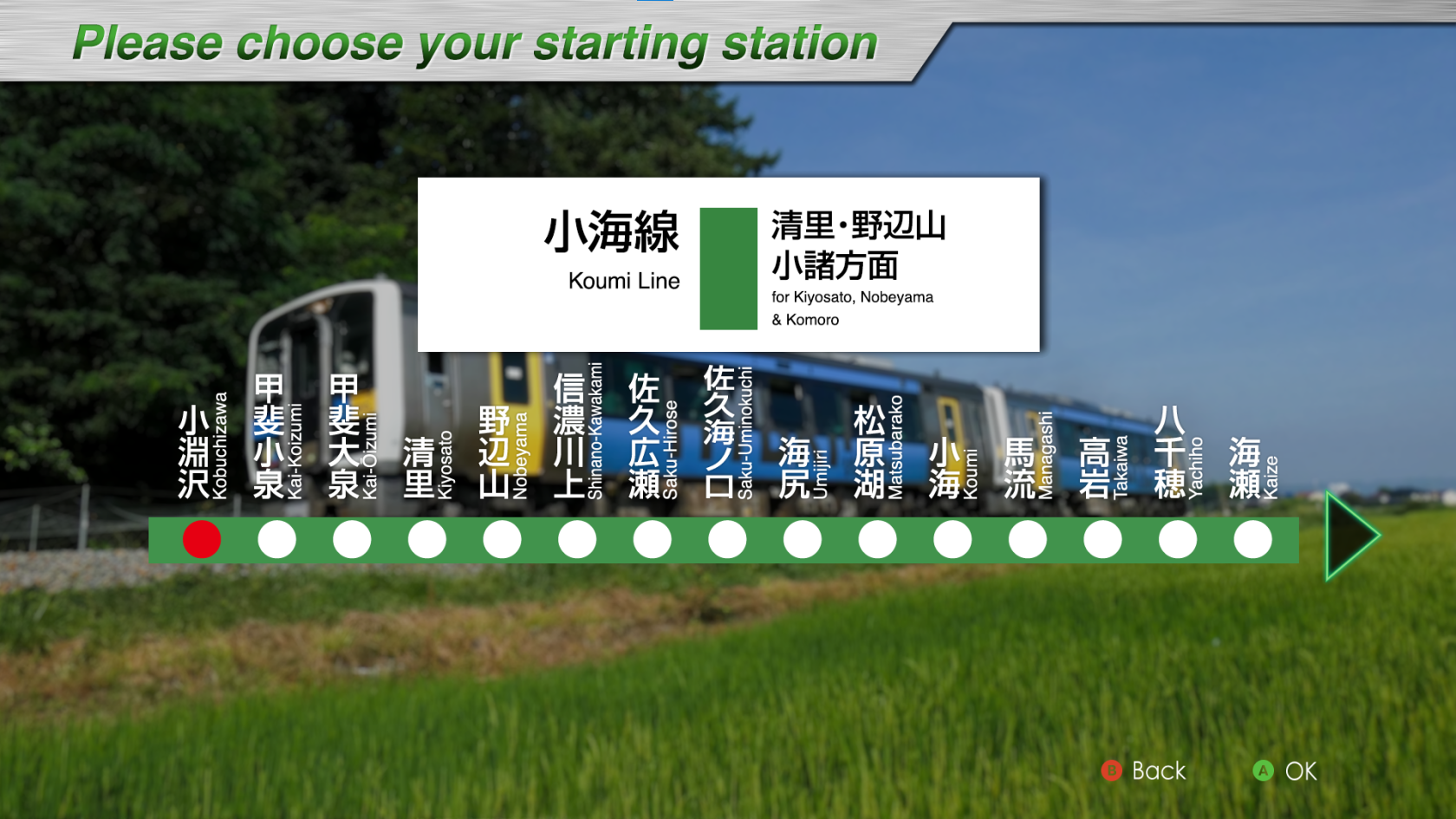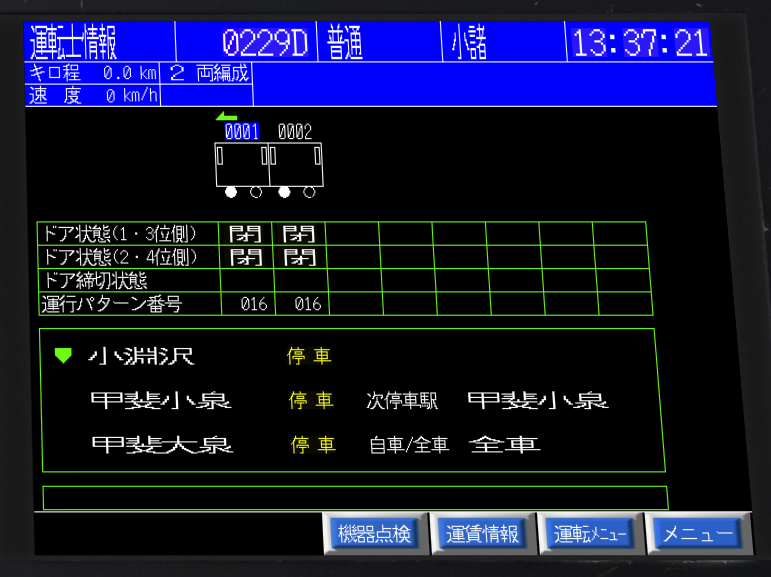Koumi Line
Introducing
The Koumi Line is a 78.9 km long line connecting Kobuchizawa Station in Hokuto City, Yamanashi Prefecture and Komoro Station in Komoro City, Nagano Prefecture. The line was opened in 1919 by its predecessor, Saku Railway, between Koumi and Komoro Stations. In 1935, the line was extended to Kobuchizawa Station and opened to traffic. Since its opening, the Koumi Line has been a popular commuter rail line and a gateway to sightseeing in Kiyosato and Nobeyama.
The greatest feature of the Koumi Line is that it runs at high elevation. Between Kiyosato and Nobeyama stations, the line passes through the highest point on the JR line at 1,375 meters above sea level, and the nine stations between Kai-Koizumi and Matsubarako stations are among the nine highest elevation stations on the JR line, giving the line its nickname, "Yatsugatake Kogen Line (Yatsugatake Plateau Line)".
Along the line, highland vegetables are cultivated at high altitude and in the cool summer climate, and near Nobeyama Station, the train runs through an expanse of highland vegetable fields. Ekiben that incorporate fresh highland vegetables from Yatsugatake picked along the line are also popular.
In July 2017, "HIGH RAIL 1375," a sightseeing train with a planetarium inside, began operation, running between Kobuchizawa and Komoro stations mainly on Saturdays and holidays.
In this DLC, the train from Kobuchizawa Station to Kai-Koizumi Station makes a major 180-degree change of direction on a curve built on embankment with the Yatsugatake mountains at its side; from Kiyosato Station to Nobeyama Station, the train runs up a steep slope with a maximum grade of 33‰ to the highest point on the JR line; and from Shinanokawakami Station to Koumi Station, the train offers a powerful view across multiple layers of the Chikuma River, known as the longest river in Japan.
Key data
- Line Length: 78.9 km
- Number of stations: 31
- Safety system: ATS-P(R)
- Train model: KiHa E200 serie
- Max speed: 85 km/h
- Max speed after signals:
- Reduced speed (green/yellow): 65 km/h
- Caution (yellow): 45 km/h
- Speed restriction (yellow/yellow): 25 km/h
- Routes:
- Nakagomi ~ Komoro (131D) : Type "Local" - 2 cars - 11 stations - 13.4 km
- Kobuchizawa ~ Nobeyama (227D) : Type "Local" - 2 cars - 5 stations - 23.4 km
- Kobuchizawa ~ Komoro (229D) : Type "Local" - 2 cars - 31 stations - 78.9 km
- In-train announcements : Yes
- Driver announcement (pointing-and-calling) : No
Console details
On the left-hand side of the console, you'll find :
- At the top, various indicators. In this order :
- Incident (事故)
- Emergency short circuit (非常短絡)
- ATS power supply (ATS電源)
- ATS in progress (ATS動作)
- Snow resistance (耐雪ブレーキ)
- Safety Brakes (直通予備)
- Cruise control (定速)
- Inspection in progress (点検中)
- Below is the ATS-P/Ps dial with the following indicators:
- Normal operation of safety systems (保安装置正常動作)
- P power supply (P電源)
- Pattern approach (パターン接近)
- Brake operation (ブレーキ動作)
- Brake release (ブレーキ開放)
- ATS-P
- ATS-Ps
- P failure (P故障)
- Ps failure (Ps故障)
- Bottom left, brake level and emergency brake indicator in red (非常) and speed limit indicator in green (抑速)
- Then the brake cylinder pressure (black arrow) and compressed air reservoir pressure(red arrow) dial
- Then the speed dial
- And finally, the door-closing indicator and pocket watch.
The right-hand section contains the screen displaying train and journey information. The top banner contains the following information:
- The name of the screen (運転土情報 - Driving information)
- The train number
- The train type (普通 - Local)
- The destination (小諸 - Komoro)
- The time of day
- The distance from departure (キロ程)
- The train formation type (2両編成 - 2 cars)
- The current speed (速度)
The next section shows the different cars. The cars can take 2 colors: blue (engines are used) or yellow (brakes are used).
Below is a table displaying the opening status of the doors (ドア状態), 1-3 being the doors on the left, 2-4 those on the right. They are open when the indicator (閉) is lit.
In the next area, on the left, we have a list containing the current station (or the one we've just left) and the next 2 stations (plus an arrow indicating the train's position) as well as the stop (停車) or passing indication. The right-hand side displays the name of the next stop (次停車駅) and whether the stop covers the whole train (全車) or just certain cars (自車).
Finally, there are a series of buttons (not usable in the simulator).
Movie
Useful links
Wikipedia: https://en.wikipedia.org/wiki/Koumi_Line
Driver's guide: https://docs.google.com/spreadsheets/d/13W8ED-yEI50aB4v5rghOVSVIH8BQW3wN35ft3O3LlTQ/edit#gid=490039574
Timetables (in japanese):
- Nakagomi ~ Komoro (131D) : https://docs.google.com/spreadsheets/d/13W8ED-yEI50aB4v5rghOVSVIH8BQW3wN35ft3O3LlTQ/edit#gid=1313179911
- Kobuchizawa ~ Nobeyama (227D) : https://docs.google.com/spreadsheets/d/13W8ED-yEI50aB4v5rghOVSVIH8BQW3wN35ft3O3LlTQ/edit#gid=1215340598
- Kobuchizawa ~ Komoro (229D) : https://docs.google.com/spreadsheets/d/13W8ED-yEI50aB4v5rghOVSVIH8BQW3wN35ft3O3LlTQ/edit#gid=1272661934



